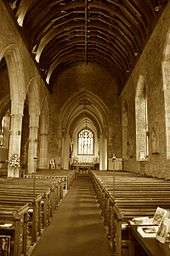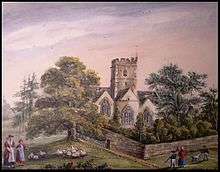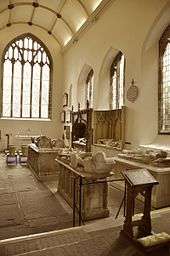Priory Church of St Mary, Abergavenny
| Priory Church of St Mary | |
|---|---|
 Priory Church of St Mary | |
| Coordinates: 51°49′17″N 3°00′55″W / 51.8214°N 3.0154°W | |
| Location | Abergavenny, Monmouthshire |
| Country | Wales |
| Denomination | Church in Wales |
| Website | Official website |
| History | |
| Founder(s) | Hamelin de Ballon |
| Architecture | |
| Status | Parish church |
| Functional status | Active |
| Heritage designation | Grade I |
| Designated | 11 July 1952 |
| Administration | |
| Deanery | Abergavenny |
| Diocese | Monmouthshire |
| Clergy | |
| Canon(s) | Revd Canon Mark Soady |
| Deacon(s) | Revd Sarah Gillard-Faulkner |
The Priory Church of St Mary, Abergavenny is a church in the centre of Abergavenny in Monmouthshire, Wales.
St. Mary's has been called 'the Westminster Abbey of Wales' because of its large size,[1] its number of high status church monument tombs and the rare medieval effigies surviving within it.[2] The church was designated as a Grade I listed building on 1 July 1952.[3]
History

It was originally the church of the Benedictine Priory, established under Hamelin de Balun the first Norman holder of the title Lord Abergavenny, which in the 1090s became Baron Bergavenny. At this time it was a cell of the Abbey of Saint Vincent at Le Mans in France. Recent archaeological surveys have revealed significant finds of Roman Samian ware pottery, suggesting that the church may have been built on the site of a previous place of Romano-British and possibly Celtic worship.
Henry de Abergavenny was a prior here and later at Llandaff in the late 12th century and was chosen to assist at the coronation of King John I of England in 1199. Successive Lords of Abergavenny were by necessity also benefactors, including William de Braose, 4th Lord of Bramber.
In 1320 John Hastings, 2nd Baron Hastings, called on The Pope to set up an investigation into the Priory, in which the monks were accused of failing to maintain the Benedictine Rule. The prior, Fulk Gaston, absconded to the mother Abbey with the church silver.
By the Dissolution of the Monasteries the Priory had only the prior and four monks. Due to the close connections between the Lords of Abergavenny and the Tudor dynasty the priory was spared and became the parish church.[4]
Description

The church is cruciform in layout and impressively large with a chancel and nave 172 feet (52 m) in length. The central tower has ten bells.
The church is mainly in the Decorated and Perpendicular Period architectural styles and was, like many churches, subjected to Victorian period refurbishment in the 19th century, with sadly little trace of the original Norman architecture surviving. The Norman baptismal font was rediscovered in the churchyard in the 19th century; it had been removed from the church in the 17th century by a local Baptist minister, John Abbot, on the grounds that he did not believe in infant baptism.
The oaken choir stalls with carved misericords and carved lattice work backs, however, are 15th-century survivals. They bear the name of the prior at that time Wynchestre and his own stall remains, slightly raised and surmounted by a mitre.
Effigies
The chief claim to fame for the church today lies in its collection of effigies. The effigies are in wood, alabaster and marble and range in date from the 13th century to the 17th century. One effigy is that of John de Hastings, Lord of Abergavenny (died 1324) and shows him as a young knight, wearing a long surcoat over a hauberk and a hood of fine chainmail.
The Lewis Chapel
The chapel is named after Dr David Lewis, first Principal of Jesus College, Oxford, whose tomb it contains. In the Lewis Chapel are two female effigies, one holding a heart in her palm, a device used to signify a possible 'heart only' burial and dates from the end of the 13th century. She is believed to be Eva de Braose and bears a shield bearing the Cantilupe Arms, which is rare for a female effigy.[5] Her neighbour, a second female effigy, dated from the 14th century, is thought to be a female member of the Hastings family who died while pursuing her pet red squirrel when it escaped and ran along the castle walls at Abergavenny Castle, causing her to fall to her death.[5] The effigy has a light chain around her waist which was documented once as having been attached to a small squirrel which formed part of the effigy. It has since been knocked off or defaced. This act of vandalism most likely dates from the Commonwealth of England period (1649 - 1660) under Oliver Cromwell.
The Herbert Chapel

The Herbert Chapel contains recumbent monuments and effigies in both alabaster and marble associated with the ap Thomas and Herbert families. Sir Richard Herbert was brought up with the young Henry Tudor, the future Henry VII, at Raglan Castle. In 1485 Herbert supported Henry's claim to the throne, fighting with him as he defeated Richard III at the Battle of Bosworth. It is this support that ultimately saw St Mary's spared the worst of the despoliation of monasteries in the dissolution.
Within the chapel are also monumental brasses dating from the 16th century and 17th century.
The Jesse
The Jesse is an elaborate, very large, 15th-century wooden carving which would have once been part of an even larger carving forming a Jesse Tree telling the lineage of Jesus Christ based on that in the Bible.[6] It is unique in Britain and described by Tate Britain as one of the finest medieval sculptures in the world. In 2016 a new stained-glass Jesse window designed by Helen Whittaker was installed in the Lewis Chapel, incorporating the wooden Jesse at its foot.[7][8][9] The project was visited in April 2016 by the Archbishop of York, the Most Revd John Sentamu;[10] and the completed work was dedicated in the presence of Charles, Prince of Wales, on 7 July 2016.[11]
The Church today
The restored Tithe Barn, within the precincts of the Priory, was opened by HRH Charles, Prince of Wales on 23 October 2008 and houses the large 24 feet (7.3 m) tapestry depicting the history of Abergavenny and embroidered by volunteers to mark the 2000 Millennium. It is now the Priory's Heritage Centre and offers interpretative information and a cafeteria / restaurant open to the public and visitors.
After 18 years as vicar canon, Jeremy Winston was appointed Dean of Monmouth. Fr Mark Soady, former Chaplain at the University of Wales, Newport was collated as vicar on the Feast of the Epiphany 2012. Fr Mark was made Prior in September 2014 and installed as a Canon of Newport Cathedral in November 2014.
After a nearly five hundred-year gap a new Monastic Community - The Holywell Community- was established on 2 September 2014.[12]
Gallery
 The tower
The tower West front
West front From the North
From the North Tower detail
Tower detail
References
- ↑ "St. Mary's Priory Church, Abergavenny (C) Jeremy Bolwell :: Geograph Britain and Ireland". Geograph.org.uk. 2008-03-01. Retrieved 18 April 2016.
- ↑ Bolwell, Jeremy. "The tomb of Sir Richard Herbert of Ewyas... (C) Jeremy Bolwell :: Geograph Britain and Ireland". Retrieved 5 January 2015.
- ↑ Good Stuff IT Services. "Church of St Mary - Abergavenny - Monmouthshire - Wales". British Listed Buildings. Retrieved 5 January 2015.
- ↑ Davies, Brian E. (2013). Wales: A Walk Through Time Flat Holm to Brecon. Amberley Publishing Limited. pp. Chapter 9. ISBN 9781445626178.
- 1 2 "Historic Monuments". St Mary's Priory. Abergavenny. Retrieved 13 January 2016.
- ↑ Bolwell, Jeremy. "The Jesse in St. Mary's Priory Church,... (C) Jeremy Bolwell :: Geograph Britain and Ireland". Retrieved 5 January 2015.
- ↑ "Plans for memorial window take step forward". Abergavenny Chronicle. 5 April 2013.
- ↑ "The Jesse Window explained". St Mary's Priory, Abergavenny. 16 June 2016. Retrieved 9 September 2016.
- ↑ Crampin, Martin (23 June 2016). "The Jesse Window explained". Stained glass from Welsh churches. Retrieved 9 September 2016.
- ↑ "St Mary's Priory, Abergavenny". Stmarysprioryabergavenny.wordpress.com. Retrieved 18 April 2016.
- ↑ "The Jesse Window is dedicated in the presence of the Prince of Wales". St Mary's Priory, Abergavenny. 8 July 2016. Retrieved 9 September 2016.
- ↑ "ST MARY'S PARISH CHURCH HOLYWELL COMMUNITY: St Mary's Priory, Abergavenny". Stmarys-priory.org. 2 September 2014. Retrieved 18 April 2016.
Further reading
- Blair, Claude (1994). "The wooden knight at Abergavenny". Church Monuments. 9: 33–52.
- Lindley, Phillip (2006). "Two fourteenth-century tomb monuments at Abergavenny and the mournful end of the Hastings Earls of Pembroke". In Kenyon, John R.; Williams, Diane M. Cardiff: architecture and archaeology in the medieval diocese of Llandaff. British Archaeological Association, Conference Transactions. 29. Leeds: Maney. pp. 136–60. ISBN 9781904350804.
- Lindley, Phillip; Galvin, Carol (2006). "New paradigms for the aristocratic funerary monument around 1300: reconstructing the tomb of John, second Baron Hastings (1287–1325) at Abergavenny Priory, Monmouthshire". Church Monuments. 21: 58–93.
- Lindley, Phillip (2007). "A Restoration restoration? The Herbert monuments at Abergavenny". Tomb Destruction and Scholarship: medieval monuments in early modern England. Donington: Shaun Tyas. pp. 199–236. ISBN 9781900289870.
- Morgan, Octavius (1872). Some Account of the Ancient Monuments in the Priory Church, Abergavenny. Newport.
- Nash, George, ed. (2015). An Anatomy of a Priory Church: the archaeology, history and conservation of St Mary’s Priory Church, Abergavenny. Oxford: Archaeopress. ISBN 978-1-78491-108-9.
- Tracy, Charles; Harrison, Hugh; Miles, Daniel (2002). "The choir-stalls at the Priory Church of St. Mary, Abergavenny". Journal of the British Archaeological Association. 155: 203–54.
- Winston, Jeremy (2000). St Mary's Priory Church, Abergavenny. Much Wenlock: R. J. L. Smith. ISBN 1872665381.
External links
- St Mary's Priory website
- History UK website
- The Choir website
- A review of the church from a mystery shopper / worshipper
- Monastic Wales website - Bibliographical sources, history and images of the priory
- Artworks at Priory Church of St Mary, Abergavenny